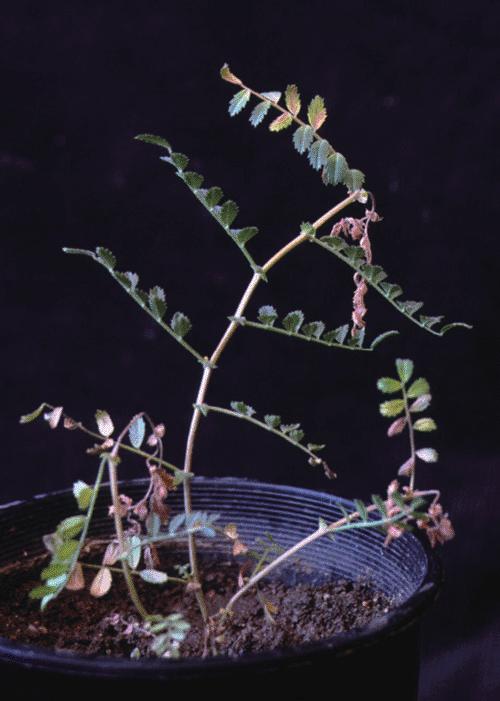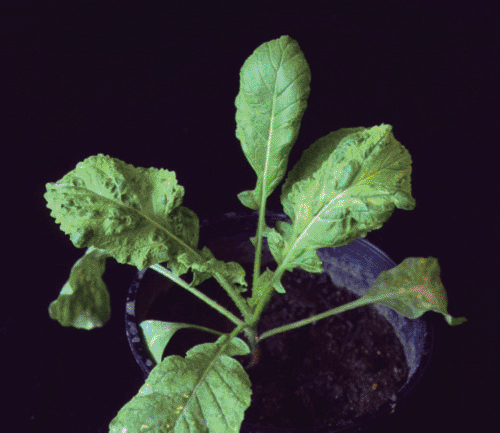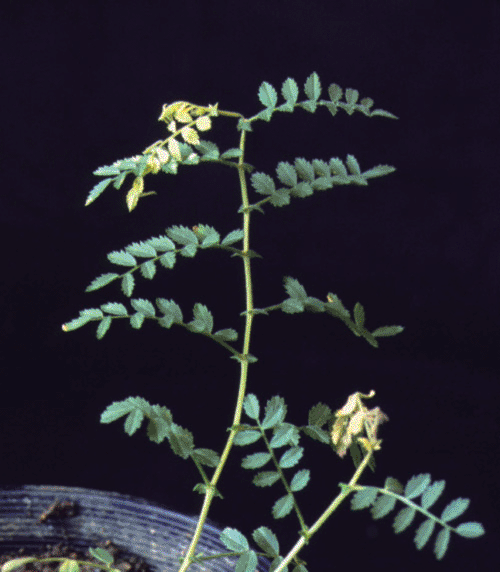First record of natural infection of chickpea by Turnip mosaic virus
M. W. Schwinghamer A C , J. E. Thomas B , J. N. Parry B , M. A. Schilg A and E. K. Dann BA New South Wales Department of Primary Industries, Tamworth Agricultural Institute, 4 Marsden Park Road, Calala, NSW 2340, Australia.
B Department of Primary Industries and Fisheries, 80 Meiers Road, Indooroopilly, Qld 4068, Australia.
C Corresponding author. Email: mark.schwinghamer@dpi.nsw.gov.au
Australasian Plant Disease Notes 2(1) 41-43 https://doi.org/10.1071/DN07020
Submitted: 1 March 2007 Accepted: 20 March 2007 Published: 29 March 2007
Abstract
Turnip mosaic virus (TuMV) was identified in chickpea (Cicer arietinum) plants with tip wilting symptoms in a commercial crop in northern New South Wales, Australia. This is a new disease record for chickpea worldwide as well as for legumes in Australia. Koch’s postulates were satisfied for TuMV as a cause of the tip wilting in chickpea.
Chickpea (Cicer arietinum) is an important pulse crop in many countries, including Australia (Knights 2004). In northern New South Wales (NSW), Australia, spring infections of chickpea with viruses are a significant production problem (M. W. Schwinghamer, unpubl. data).
A common virus-like symptom in chickpea is tip wilting, i.e. wilting and/or necrosis of shoot tips, concomitant with or leading to reddening, chlorosis, and premature death of entire plants. At least four virus species cause this symptom in Australia (Thomas et al. 2004): Lettuce necrotic yellows virus (LNYV), Alfalfa mosaic virus (AMV), Bean yellow mosaic virus (BYMV) and Tomato spotted wilt virus (TSWV). However, our serological tests for these and up to nine other virus species or groups have sometimes been negative for chickpea plants displaying tip wilting.
In 2003, mechanical transmissions from chickpea field specimens with tip wilting to chickpea cv. Amethyst were done to identify the causal agents. One isolate (3696F) that reproduced tip wilting (Fig. 1) was negative in tissue blot immunoassays (TBIAs) for AMV, BYMV, Cucumber mosaic virus (CMV) and TSWV and enzyme-linked immunosorbent assay (ELISA) for LNYV. However, TBIA and ELISA with monoclonal antibody PTY 1 (AGDIA Inc.) were positive for the genus Potyvirus, and filamentous particles characteristic of Potyvirus species were detected by negative stain electron microscopy. The isolate and its source plant were lodged in the NSW culture collection as accession DAR 76855. The source plant was taken from a crop of cv. Jimbour near Narrabri (S 30°13.57′, E 149°38.15′), NSW, on 19 September 2003.

|
Isolate 3696F was identified as Turnip mosaic virus (TuMV, genus Potyvirus) by serological and pathogenicity tests. An indirect TBIA with TuMV antiserum (Bio-Rad Phyto-Diagnostics, INRA, France) as the primary reagent and alkaline phosphatase-conjugated goat anti-rabbit antiserum as the second reagent gave clearly distinguishable positives for both the source plant (Fig. 2) and the isolate. Mechanical transmission to five Brassicaceae hosts including turnip weed (Rapistrum rugosum, Fig. 3) gave symptoms typical of TuMV infection and positive TuMV and Potyvirus TBIA reactions. Transmissibility to Brassicaceae hosts has diagnostic significance because TuMV is considered the only Potyvirus species able to infect Brassicaceae (Walsh and Jenner 2002).

|

|
The chickpea isolate (3696F) and four Brassicaceae isolates of TuMV were transmitted from inoculated turnip weed to chickpea, giving tip wilting symptoms in every case. The symptoms for a Brassicaceae (mustard) isolate are shown in Fig. 4. TBIAs on the inoculated chickpeas confirmed the presence of TuMV and absence of four other mechanically transmissible virus species (AMV, BYMV, TSWV, and Pea seed-borne mosaic virus) for the chickpea isolate and two Brassicaceae isolates that were tested by TBIAs.

|
Confirmation that 3696F was TuMV was obtained by cloning and sequencing of reverse transcription PCR (RT-PCR) products. Nucleic acid was extracted from freeze-dried leaf tissue by the leaf soak method of Thomson and Dietzgen (1995), and RT-PCR with potyvirus primers U341 and Poty1 conducted essentially as described by Gambley et al. (2004). The ~700-bp product was excised from the agarose gel, extracted using a QIAEX 11 Gel Extraction Kit (QIAGEN) and cloned using a pGEM-T Easy cloning kit (Promega). DNA minipreps were made from selected clones using the QIAPrep Spin Miniprep Kit (QIAGEN) and sequencing reactions prepared using the Big Dye Terminator Cycle Sequencing Kit (Applied Biosystems) and run on an ABI automatic sequencer at the Australian Genome Research Facility. The 640-nucleotide sequence lodged with GenBank as accession EF444929, comprising the 3′ end of the coat protein coding region and the 3′ untranslated region, showed 99% identity with over 50 TuMV entries on GenBank when analysed by BLASTn.
TuMV has been reported to infect chickpea (Provvidenti 1978) and a wide range of other hosts experimentally, and at least five other legume species naturally (Edwardson and Christie 1991). However, we are not aware of any previous reports of TuMV naturally infecting chickpea anywhere or of TuMV infecting any legume species naturally in Australia. It will be important to include tests for TuMV in future work on chickpea viruses, particularly where symptoms of tip wilting are evident.
Our results satisfy Koch’s postulates as redefined by Bos (1999) for TuMV as a cause of tip wilting in chickpea on the following bases: TuMV was associated with tip wilting in chickpeas the field by TBIA, transmission of the chickpea isolate to Brassicaecae hosts was a selective isolation procedure, the chickpea isolate in turnip weed and four Brassicaceae isolates all produced tip wilting when inoculated onto chickpea, and four other virus species known to cause tip wilting were not present in these isolates based on TBIAs.
Acknowledgements
This work was supported by Grains Research and Development Corporation, New South Wales Department of Primary Industries, and the Department of Primary Industries and Fisheries, Queensland.
Gambley CF,
Thomas JE,
Magnaye LV, Herradura L
(2004) Abacá mosaic virus: a distinct strain of Sugarcane mosaic virus. Australasian Plant Pathology 33, 475–484.
| Crossref | GoogleScholarGoogle Scholar |

Provvidenti R
(1978) A mosaic of Pisum sativum caused by a strain of turnip mosaic virus. Plant Disease Reporter 62, 482–485.

Thomas JE,
Schwinghamer MW,
Parry JN,
Sharman M,
Schilg MA, Dann EK
(2004) First report of Tomato spotted wilt virus in chickpea (Cicer arietinum) in Australia. Australasian Plant Pathology 33, 597–599.
| Crossref | GoogleScholarGoogle Scholar |

Thomson D, Dietzgen RG
(1995) Detection of DNA and RNA plant viruses by PCR and RT-PCR using a rapid virus release protocol without tissue homogenisation. Journal of Virological Methods 54, 85–95.
| Crossref | GoogleScholarGoogle Scholar | PubMed |

Walsh JA, Jenner CE
(2002) Turnip mosaic virus and the quest for durable resistance. Molecular Plant Pathology 3, 289–300.
| Crossref | GoogleScholarGoogle Scholar |



